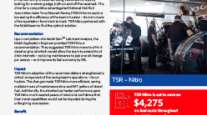Diesel Average Slips to $4.01 After 3rd Straight Weekly Drop
This story appears in the Nov. 12 print edition of Transport Topics.
The price of diesel fuel in the United States declined for the third straight week, dipping 2 cents to $4.01 per gallon, the lowest level in almost three months, the Department of Energy reported last week.
Meanwhile, increased demand for gasoline for vehicles and to fuel generators brought long lines to filling stations in the ravaged portions of New Jersey and New York City as residents struggle to recover from Hurricane Sandy in the prior week. But diesel lines were short, trucking industry leaders said.
Diesel’s price decrease followed an 8.6-cent drop the week before. Diesel is now at its lowest price since the $3.965-a-gallon average price on Aug. 13. Diesel has fallen in five of the past seven weeks.
The average gasoline price fell 7.6 cents in DOE’s Nov. 5 weekly survey of fueling stations, to $3.492 a gallon, after an 11.9-cent drop the previous week. It was the fourth straight decline for gas, which has fallen in six of the past seven weeks.
Despite the declines, the diesel average is still 12.3 cents higher than it was a year ago, a 3.2% increase. The gasoline average was 6.8 cents, or 2%, above its year-ago figure.
Despite the overall drop and declines in every other region that DOE tracks, diesel rose by 0.6 cent in the Mid-Atlantic and New England, thanks to the storm. Gasoline increased 0.3 cent in New York City.
As travel increased in New Jersey and New York after Sandy, demand grew among motorists for gasoline, and drivers had difficulty finding fuel, DOE’s Energy Information Administration reported.
But the fuel issues did not extend to diesel because demand is much lower, said Gail Toth, executive director of the New Jersey Motor Truck Association.
“We have more of an issue right now with gasoline than we do with diesel,” Toth said last week. “In the beginning, we had guys who were desperately low on diesel, but everyone seems to be doing OK.”
Toth said that, in the days after the storm, carriers in New Jersey told her that some fueling stations had raised prices in violation of state regulations that prohibit price gouging.
“I told my guys to go complain,” Toth said, explaining that the state prohibits raising prices on fuel by more than 10% because of disasters. The price gouging generally did not last long, she said.
Based on reports last week from New Jersey carriers, Toth concluded that the trucking industry was not having trouble finding diesel.
Toth credited the lack of diesel issues to the state’s emphasis on ensuring proper fuel supply, including prioritizing fueling stations in the repair of utilities damage.
In the days immediately following the storm, the lack of fuel made it difficult for carriers to operate.
“We couldn’t find diesel even if we could run our warehouse immediately because gas stations were shut,” said Patrick Cory, managing partner of Cory First Choice Home Delivery Service, Secaucus, N.J. He credited Penske Truck Leasing with providing fuel when it was scarce. “We had people who couldn’t get to the building because they had no gas,” he said.
But diesel became easier to find within days, Cory said.
Kendra Adams, president of the New York State Motor Truck Association, saw a similar situation in her state. “I think, initially, there may have been problems, just because of the power issues,” Adams said. “We aren’t hearing the same reports of the diesel shortages as we were for gasoline.”
Stephen Schork, principal of Schork Group Inc., Villanova, Pa., said that the drop in fuel prices could be attributed partially to Hurricane Sandy.
“There was an initial demand shock after the storm, with roads closed, airports closed, trees and power lines down across roads. So travel was diminished,” Schork told TT.
But he warned that as travel increases and the region recovers more, prices are likely to increase as well.
The 2-cent decrease in the average diesel price is part of a weeks-long decline, likely because of seasonal falling demand, Schork said.
In a Nov. 7 report, DOE estimated that diesel will average $3.83 next year, a dime higher than its estimate in the same report last month. Diesel will average $4 in the current fourth quarter, DOE said in its monthly Short-Term Energy Outlook.
Meanwhile, the price of crude oil dropped by the largest amount this year after President Obama won re-election over Republican challenger Mitt Romney. Crude fell $4.27 on the New York Mercantile Exchange to $84.44 Nov. 7, its lowest point since July, after rising earlier in the week to a peak of $88.71 on Nov. 6.
Worries about economic growth were given as the reason for the sharp drop in crude.
“The prospect of the ‘fiscal cliff’ is a dark cloud over the market,” Chip Hodge, senior managing director at Manulife Asset Management, told Bloomberg News, referring to the more than $600 billion in tax increases and spending cuts set for the end of the year.
Senior Reporter Rip Watson contributed to this report.




